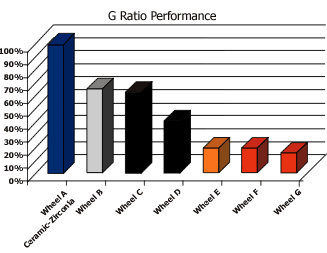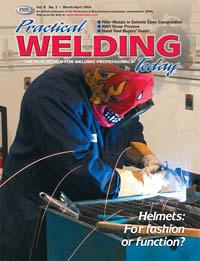Contributing Writer
- FMA
- The Fabricator
- FABTECH
- Canadian Metalworking
Categories
- Additive Manufacturing
- Aluminum Welding
- Arc Welding
- Assembly and Joining
- Automation and Robotics
- Bending and Forming
- Consumables
- Cutting and Weld Prep
- Electric Vehicles
- En Español
- Finishing
- Hydroforming
- Laser Cutting
- Laser Welding
- Machining
- Manufacturing Software
- Materials Handling
- Metals/Materials
- Oxyfuel Cutting
- Plasma Cutting
- Power Tools
- Punching and Other Holemaking
- Roll Forming
- Safety
- Sawing
- Shearing
- Shop Management
- Testing and Measuring
- Tube and Pipe Fabrication
- Tube and Pipe Production
- Waterjet Cutting
Industry Directory
Webcasts
Podcasts
FAB 40
Advertise
Subscribe
Account Login
Search
Don't throw away your profit margin
- By Debbie Gaspich
- April 6, 2004
- Article
- Consumables
Grinding applications can be divided into three broad categories, especially with regard to tube and pipe:
- Welding preparation and heavy metal removal
- Metal fabrication and construction
- Light metal removal, finishing and sharpening
Abrasives for grinders come in many grains, shapes, and product designs to meet the needs of every application.
Choosing the best abrasive product for an application and using the products to their greatest potential by following the manufacturer's recommendations can help you achieve higher productivity, and often higher productivity results in lower overall costs.
Cost reduction programs in fabrication facilities can begin with abrasives testing before purchase. The productivity gains that can be realized by such product testing may come in small, incremental steps, but on an annual basis, they can add up to significant fabrication and welding cost savings.
Testing abrasives before full-scale application can save time and money if you match the product with the application.
Test Parameters
Set up test parameters and follow them consistently for each wheel tested. Bring grinders up to full speed before grinding, and timing with a stopwatch, cut or grind with the test wheel, as you normally would, for 10 minutes or until it stubs out, whichever comes first. This test technique is simple, but it will help you determine the cost and performance advantages of each wheel tested.
Advantages of each wheel include wheel life or the amount of material that wheels can remove before stubbing out, as well as the time it takes to remove a certain amount of unwanted material, which equates to productivity. Wheel life relates to the cost advantage. A wheel that costs 50 percent more while removing twice as much material, for instance, is more cost-effective. Longer life and faster cutting are performance advantages, which can help reduce the overall cost of the operation.
For example, in one test procedure measuring the G ratio—the ratio of material removal from the workpiece to the necessary volume of abrasive required for this purpose—one type 01 cutoff wheel cut only three pieces of carbon steel before it stubbed out. Two other wheels cut five and seven parts, respectively, and one ceramic-zirconia wheel cut 12 parts before it was ground to the stub. Similar results were achieved on stainless steel: four, four, five, and 10 parts, respectively (see Figure 1).
 |
| Figure 1 G ratio measures grinding efficiency, calculated by dividing the cubic inches of metal removed by the cubic inches of wheel wear. |
In another test at a customer site on actual product, three depressed-center wheels measuring 4 15/16 inches in diameter were used to grind weld beads. Using constant contact time for exactly 10 minutes, the wheels lost 1 7/16, 9/16, and 3/16 in., respectively, of abrasive surface during the test, demonstrating that the least expensive wheel typically doesn't result in the greatest productivity. Again, a ceramic-zirconia wheel had the most abrasive remaining at the end of the test, meaning it lost the least amount of abrasive throughout the test period.
Consistency of operation and wheel wear were the productivity measurements in each test because these are verifiable ways to lower cost.
Proper grinding wheel usage = operator safety
While developing more advanced grinding and finishing products can make work easier for grinder operators, safety always must be the prime concern.
Unfortunately, breakproof wheels don't exist. Grinding wheels are made of thousands of small abrasive grains that have been bonded together with an organic resin compound. The bond must be strong enough to hold the abrasive grains in place, yet friable enough to release dull grain and expose fresh cutting points. An unbreakable wheel simply wouldn't grind.
Therefore, you must follow safety procedures as recommended by the industry. You must wear safety glasses and face protection when using abrasive products. And because grinding applications are conducted in harsh environments, safety gloves also are recommended.
Improper use of a grinding wheel is a leading cause of accidents involving abrasives. Safe practices can reduce these problems significantly. Always check machine speed against the operating speed marked on the grinding wheel, and never overspeed a grinding wheel. Use a wheel guard that is appropriate for the grinding wheel mounted on the machine. When mounting cutoff or bench and pedestal wheels, use only flanges of equal diameter and proper size.
Observe these safety tips as a matter of course:
Check all wheels for cracks or damage before use.
Run wheels in a protected area for one minute before grinding.
Don't use wheels that have been dropped or otherwise damaged.
Don't use heavy side pressure on any Type 01 straight wheel or Type 27 thin wheel.
Don't use a grinding wheel with a rated speed less than that of the grinder. Never overspeed a grinding wheel.
Rotate grinding wheel stock so that the oldest grinding wheel is used first.
Comply with American National Standards Institute (ANSI) and Occupational Safety and Health Administration (OSHA)
guidelines, as well as instructions supplied by grinding wheel and machine manufacturers.
The grinding wheel is one of the most widely used industrial tools. Coupled with some simple safety guidelines, it also can be one of the safest.
Debbie Gaspich is product manager of welding grinding products for Saint-Gobain Abrasives, One New Bond St., Box 15008, Worcester, MA 01615-0008, 716-731-7555, Deborah.A.Gaspich@saint-gobain.com, www.sgabrasives.com.
Saint-Gobain Abrasives offers a CD-ROM with information on the abrasive test procedures discussed in this article. Mail a request on company stationery or send an e-mail request with your company e-mail address to Barry D. Cole at Saint-Gobain Abrasives, Barry.D.Cole@saint-gobain.com.
American National Standards Institute, www.ansi.org
Occupational Safety and Health Administration, www.osha.gov
About the Author
About the Publication
subscribe now

The Welder, formerly known as Practical Welding Today, is a showcase of the real people who make the products we use and work with every day. This magazine has served the welding community in North America well for more than 20 years.
start your free subscription- Stay connected from anywhere

Easily access valuable industry resources now with full access to the digital edition of The Fabricator.

Easily access valuable industry resources now with full access to the digital edition of The Welder.

Easily access valuable industry resources now with full access to the digital edition of The Tube and Pipe Journal.
- Podcasting
- Podcast:
- The Fabricator Podcast
- Published:
- 04/16/2024
- Running Time:
- 63:29
In this episode of The Fabricator Podcast, Caleb Chamberlain, co-founder and CEO of OSH Cut, discusses his company’s...
- Trending Articles
Sheffield Forgemasters makes global leap in welding technology

ESAB unveils Texas facility renovation

Engine-driven welding machines include integrated air compressors

The impact of sine and square waves in aluminum AC welding, Part I

Compact weld camera monitors TIG, plasma processes

- Industry Events
16th Annual Safety Conference
- April 30 - May 1, 2024
- Elgin,
Pipe and Tube Conference
- May 21 - 22, 2024
- Omaha, NE
World-Class Roll Forming Workshop
- June 5 - 6, 2024
- Louisville, KY
Advanced Laser Application Workshop
- June 25 - 27, 2024
- Novi, MI


























